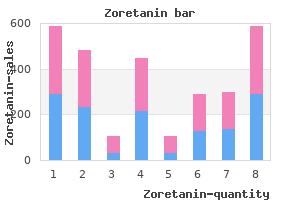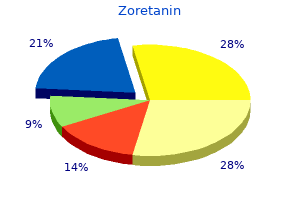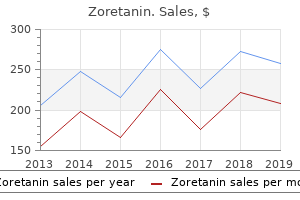

 5100 Springfield St. Suite 108, Dayton, Ohio 45431-1274
5100 Springfield St. Suite 108, Dayton, Ohio 45431-1274Zoretanin
"Purchase zoretanin now, acne scars".
By: R. Agenak, M.B. B.A.O., M.B.B.Ch., Ph.D.
Co-Director, The Brody School of Medicine at East Carolina University
In superficial locations skin care not tested on animals order zoretanin uk, they present as small acne light treatment discount zoretanin 30 mg with mastercard, soft acne 8 months postpartum discount 5 mg zoretanin mastercard, and mobile lesions that are painless. More deep-seated lesions can grow to a much larger size before they are detected clinically. Often they will manifest as increasing size or circumference of an extremity or become noticeable as an asymmetric limb when a patient loses weight. Conventional lipomas display cytogenetic abnormalities in over half of investigated cases. Some of the most common abnormalities include recombination of 12q13-15 with a variety of partners, aberrations involving 6p21-23, or loss of 13q. There does not appear to be any prognostic significance associated with any of these cytogenetic variations. These are characterized by a prominent small vessel proliferation interspersed within the fat (Figure 4. For some reason, these lesions are frequently multiple and, unlike other lipomas, can be painful. This variant of lipoma occurs most frequently in women and tends to be deep seated. Chondroid lipoma is a rare variant of lipoma containing chondroid matrix material and chondroblasts within an otherwise circumscribed lipoma (Figures 4. They are comprised of mature adipose tissue that is virtually indistinguishable from normal fat (Figure 4. Frequently, lipomas are surrounded by a thin capsule, which may be apparent at the time of excision, but is often not identifiable on microscopy. Lipomas frequently show "degenerative" changes within the central portion of the lesion (Figure 4. Lipomas may also contain a focal myxoid matrix, a feature that can cause some diagnostic confusion (Figure 4. Common histologic variants of lipoma include the so-called intramuscular variant, also sometimes referred to as "infiltrating lipoma. They have a tendency to condense on the slide, forming aggregates that may be difficult to examine cytologically (Figure 4. In addition, because of the condensation on the slide, the cellular fragments may appear more cellular than one would normally attribute to a benign, relatively paucicellular lesion such as a lipoma (Figure 4. This represents an artifact of aspiration and should not be confused with a more ominous lesion. Adipocyte nuclei may appear relatively more prominent because of the overall condensation of the lesional tissue. Occasional confusion may arise when "floret" cells are present in aspirates of the so-called "pleomorphic" variant of lipoma (see Section 4. Ancillary techniques may be needed to exclude a low-grade lipomatous tumor (see Section 4. This process is not a discrete lipoma, but a lipomatous infiltration of the subsynovial soft tissues. Histologically, there is expansion of the subsynovial soft tissues with benignappearing fat (Figure 4. Myxolipomas lack a significant vascular component and lipoblasts (features associated with myxoid liposarcoma). The vascular proliferation tends to be concentrated at the periphery of the lipoma. This is a circumscribed lesion, which frequently presents in the trunk, neck, or shoulders of middleaged to elderly men, median age of 55 years. Spindle cell/pleomorphic lipomas may be confused with more aggressive lesions due to the overall cellularity of the neoplasm.

Epithelial inclusion cysts (epidermoid and dermoid cysts) are distinguished by their lining and cyst contents acne 9 year old daughter zoretanin 5 mg line, with epidermoids showing only keratinizing stratified squamous epithelium and sheets of anucleate flattened squames for contents zone stop acne - order 40 mg zoretanin with amex, and dermoids displaying a wall that includes dermal appendages acne 11 year old purchase zoretanin master card, such as sebaceous glands and hair follicles, and contents that include not only anucleate squames but also matted hair. Both of these cysts exhibit a very similar epithelial lining, consisting of ciliated pseudostratified columnar epithelium with goblet cells. Epidermoid cysts differ from dermoid cysts in that the lining of epidermoids is composed of only keratinizing squamous epithelium. Dermoids also include skin adnexal appendage structures, such as sebaceous glands and hair follicles. A rare extreme form of multiple metastasis, called military metastasis ("carcinomatous encephalitis"), in which innumerable minute metastases shower the brain, is most common with lung adenocarcinomas. Isolated dural metastases most often represent spread from breast cancers, and single metastases to the leptomeninges and subarachnoid space usually occur with lung, breast and gastric adenocarcinomas; hematopoietic tumors; and melanomas. Prostate carcinomas frequently metastasize to the skull and spine but only rarely involve the brain parenchyma. In some, neoplasms of systemic organs are most prominent, but nervous system tumors also occur. Thus, malignant gliomas occur in Li-Fraumeni syndrome, and medulloblastomas are associated with gastrointestinal tumors in Turcot syndrome. A B Tuberous Sclerosis (Bourneville Disease) Tuberous sclerosis is an autosomal dominant disease characterized by hamartomas (tubers) of the brain, retina and viscera, as well as various neoplasms. It reflects disordered migration and arrested maturation of neuroectoderm, leading to formation of "tubers" in the cerebral cortex and of subependymal giant cell astrocytomas. The tubers are discrete cortical areas with bizarre cells with neuronal and glial features. Metastases to the central nervous system commonly produce multiple lesions in both the brain (A) and spine (B). Metastatic tumor masses typically show very sharp "pushing" borders with the adjacent brain tissue, as illustrated here with metastatic carcinoma immunostained for keratin. Sturge-Weber Syndrome (Encephalofacial Angiomatosis) Sturge-Weber syndrome is a rare, nonfamilial congenital disorder characterized by angiomas of the brain and face. Portion of cerebral cortex with overlying capillary angioma involving the leptomeninges and underlying cortical calcification (purple). The facial lesion is usually unilateral and is called a port wine stain (nevus flammeus). The leptomeninges contain large angiomas, which in severe cases may occupy an entire hemisphere. The link between angiomas of the face and brain may reflect the continuity of the embryologic vascular supply to the telencephalon, the eye and the overlying skin. In some cases, it is broadly expressed in neuron populations throughout the brain and spinal cord, and so results in a diffuse encephalomyelitis. The latter exemplify the importance of clinical recognition and accurate diagnosis of paraneoplastic syndromes. Paraneoplastic neurologic disorders occur when an immune response against a tumor antigen recognizes an antigen, usually a protein, on a nervous system cell (onconeural antigens). Paraneoplastic manifestations may precede clinical signs of the primary tumor, sometimes by years, and successful treatment of the cancer often results in resolution of the paraneoplastic syndrome associated with it. The clinical signs and symptoms of a given syndrome depend on where the neurons that express the particular Progressive Cerebellar Degeneration this paraneoplastic syndrome may be the presenting feature of an underlying malignancy and can be devastating. It occurs most often in association with breast cancer and, less often, Hodgkin lymphoma.

The more dangerous proliferative retinopathy does not appear until at least 10 years of diabetes skin care not tested on animals proven zoretanin 20 mg, after which its incidence increases rapidly and remains high for many years skin care ingredients order zoretanin american express. In type 1 diabetes acne 4 hour cheap zoretanin 10mg fast delivery, the frequency of proliferative retinopathy correlates with the degree of glycemic control; patients whose diabetes is better controlled develop retinopathy less frequently. The relationship between retinal microvascular disease and blood glucose levels in type 2 diabetes is less clear, and other parameters. Retinal ischemia can account for most features of diabetic retinopathy, including the cotton-wool spots, capillary closure, microaneurysms and retinal neovascularization. Ischemia results from narrowing or occlusion of retinal arterioles (as from arteriolosclerosis or platelet and lipid thrombi) or from atherosclerosis of the central retinal or ophthalmic arteries. The optic nerve head is edematous; the retina contains numerous "cotton-wool spots" (arrows). The commonly associated arteriolosclerosis affects the appearance of the retinal microvasculature. This effect is due to a thickening of the venular wall rather than to an impediment to blood flow caused by compression; the column of blood proximal to the compression is not wider than the part distal to the crossing. Impaired axoplasmic flow within the nerve fiber layer, caused by ischemia, results in swollen axons with cytoplasmic bodies. Hemorrhages are common in the retina, and exudates frequently form a star around the macula. The retinopathy begins at the posterior pole but eventually may involve the entire retina. On funduscopy, the first discernible clinical abnormality in background diabetic retinopathy is engorged retinal veins, with localized sausage-shaped distentions, coils and loops. This is followed by small hemorrhages in the same areas, mostly in the inner nuclear and outer plexiform layers. With time, "waxy" exudates accumulate, chiefly in the vicinity of the microaneurysms. The retinopathy of elderly diabetic persons frequently displays numerous exudates (exudative diabetic retinopathy), which are not seen with type 1 diabetes. Because of the hyperlipoproteinemia of diabetics, the exudates are rich in lipid and thus appear yellowish (waxy exudates). Delicate new blood vessels grow along with fibrous and glial tissue toward the vitreous body. Retinal neovascularization is a prominent feature of diabetic retinopathy and of other conditions caused by retinal ischemia. Tortuous new vessels first appear on the surface of the retina and optic nerve head and then grow into the vitreous cavity. The newly formed friable vessels bleed easily, and resultant vitreal hemorrhages obscure vision. Neovascularization is associated with proliferation and immigration of astrocytes, which grow around the new vessels to form delicate white veils (gliosis). The proliferating fibrovascular and glial tissue contracts, often causing retinal detachment and blindness. Frequently, features of hypertensive and arteriolosclerotic retinopathy are associated with diabetic retinopathy. Diabetic retinopathy, glaucoma and age-related maculopathy are the leading causes of irreversible blindness in the United States. Blindness in diabetic retinopathy results when the macula is involved, but it also follows vitreous hemorrhage, retinal detachment and glaucoma. Once blindness ensues, it heralds an ominous future for the patient, because death from ischemic heart disease or renal failure often follows.

Syndromes
It is important to remember that some microorganisms may have more than one mode of transmission skin care 0-1 years purchase zoretanin online from canada. The duration of isolation precautions along with additional measures for various infectious conditions and incubation periods of various infectious diseases are summarized in Appendix 7 acne while pregnant order zoretanin 10 mg amex. Procedures that are likely to create significant aerosols; suctioning acne during pregnancy discount zoretanin express, dentistry, intubation, chest physiotherapy, etc. Isolation in a single room is not required unless these patients are profoundly immunosuppressed. The patients who are at greatest risk are the individuals who are severely neutropenic. In addition to the above precautions, the following precautions should be implemented when dealing with immunocompromised patients: In an outpatient waiting room, additional precautions for the control of airborne transmission of disease may be required. These patients should be seen ahead of others in the waiting room to minimize the time they are exposed to other patients in the waiting area. Where invasive medical or dental procedures are involved, it would be reasonable to place immunocompromised patients at the start of the operating schedule, if possible. Practical issues and considerations Isolation and management of infected patients Accident and emergency the initial point of contact between a hospital and the infectious patient may be the A&E department. There is a greater risk of transfer of microorganisms in A&E as they are often crowded and patients may have to wait for prolonged periods in a communal waiting area with other patients, thus increasing the risk of transmission of infections. This risk must be minimized by establishing a fast track or triage system for potentially infectious patients with early isolation in a single room with en suite toilet and implementation of appropriate infection control precautions until they are transferred to other wards or departments. Admissions policy An admissions policy and procedure to deal with potentially infectious patients, interhospital transfers, and patients from overseas should be drawn up to reduce the risk of not only infectious diseases but to reduce the risk of transmission of multiresistant pathogens. Patient placement and cohorting All patients with suspected/proven infection must be isolated in a single room, preferably with en suite toilet facilities, and this must be done at the time of admission. It is essential that, for patients who are nursed in a single room/cohorted, staff should ensure that visitors and other staff are made aware of the infection risk and precautions to take to prevent cross-infection. A suitable door sign must be placed on the entrance door to alert both staff and visitors. The sign should be prominently displayed, providing sufficient information whilst ensuring that there is no breach of confidentiality. Some health care facilities prefer to use door signs which specify the type of isolation precautions and this can be used according to local policy but care must be taken not to stigmatize the patient in isolation. If the hospital lacks single rooms for isolation of patients, it is essential that they have a written guideline which outlines the priorities for isolation of patients based on local epidemiology and the risk assessment. If there is no dedicated ward, consider cohorting patients into bays within a ward. The dedicated rooms, bays, and areas used for isolated patients must have dedicated hand hygiene and toilet facilities. For effective isolation, bays should have doors that can be closed to provide physical separation from other patients. When a side room or cohorting is not possible, maintain a spatial separation of at least 1 metre (3 feet) between the infected patient and other patients and visitors. Notification should be made on clinical suspicion of the disease, it is not necessary to wait for laboratory confirmation of the infection. Depending on the type of infection, initial notification should be made by telephone to initiate the proper follow-up process as soon as possible.
Buy zoretanin 5mg. DRUGSTORE SKINCARE | Faves & Hates - Tati (GlamLifeGuru).